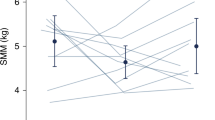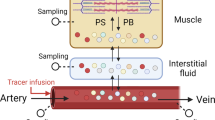Abstract
Background:
Measurement of magnesium (Mg) status is problematic because tissue Mg deficiency can be present without low serum Mg concentrations.
Objective:
To evaluate a modified version of the Mg retention test using stable isotopes for the assessment of Mg status in general, and the detection of marginal Mg deficiency in particular.
Design:
A modified version of the Mg retention test using a small dose of 26Mg was evaluated for assessment of Mg status in 22 healthy subjects. Muscle Mg concentration was used as reference for Mg status. A muscle biopsy was taken from the lateral portion of the quadriceps muscle from each subject. After 2 to 4 weeks, 11 mg of 26Mg (as MgCl2 in 14 ml water) were injected i.v. over a period of 10 min and all urine was collected for the following 24 h. Excretion of the isotopic label was expressed as percentage of the administered dose excreted in urine within 24 h.
Results:
Mean±s.d. Mg concentration in muscle was 3.85±0.17 mmol/100 g fat-free dried solids. Mean±s.d. excretion of the injected dose within 24 h was 7.9±2.1%. No correlation was found between muscle Mg concentration and excretion of the isotopic label (r2=0.061, P=0.27).
Conclusions:
In this study, urinary excretion of an intravenous Mg tracer was not influenced by muscle Mg concentration and its usefulness for the detection of marginal Mg deficiency could therefore not be demonstrated.
Sponsorship:
Swiss Foundation for Nutrition Research and Swiss Federal Institute of Technology, Zurich, Switzerland.
This is a preview of subscription content, access via your institution
Access options
Subscribe to this journal
Receive 12 print issues and online access
$259.00 per year
only $21.58 per issue
Buy this article
- Purchase on Springer Link
- Instant access to full article PDF
Prices may be subject to local taxes which are calculated during checkout



Similar content being viewed by others
References
Aikawa JK (1958). Urinary and fecal excretion of orally administered Mg28. Proc Soc Exp Biol Med 10, 29–31.
Bergström J (1962). Muscle electrolytes in man. Scand J Clin Lab Invest 14, 1–110.
Bohmer T, Mathiesen B (1982). Magnesium deficiency in chronic alcoholic patients uncovered by an intravenous loading test. Scand J Clin Lab Invest 42, 633–636.
Bohn T, Walczyk T, Davidsson L, Pritzkow W, Klingbeil P, Vogl J et al. (2004). Comparison of urinary monitoring, faecal monitoring and erythrocyte analysis of stable isotope labels to determine magnesium absorption in human subjects. Br J Nutr 91, 113–120.
Brown E, Hopper J, Hodges JL, Bradley B, Wennesland R, Yamauchi H (1962). Red cell, plasma, and blood volume in healthy women measured by radiochromium cell-labeling and hematocrit. J Clin Invest 41, 2182–2190.
Caddell JL, Calhoun NR, Howard MP, Patterson KY, Smith Jr JC (1981). Parenteral magnesium load testing with 28Mg in weanling and young adult rats. J Nutr 111, 1033–1044.
Caddell JL, Heineman E, Reed GF (1984). An evaluation of the parenteral magnesium load test in weanling rats. J Nutr 114, 1260–1265.
D-A-CH (2000). Referenzwerte für die Nährstoffzufuhr. Umschau Braus: Frankfurt/Main.
Dai LJ, Ritchie G, Kerstan D, Kang HS, Cole DE, Quamme GA (2001). Magnesium transport in the renal distal convoluted tubule. Physiol Rev 81, 51–84.
Danielson BG, Johansson G, Ljunghall S (1979). Magnesium metabolism in healthy subjects. Scand J Urol Nephrol Suppl (51), 49–73.
De Laeter JR, Böhlke JK, De Bievre P, Hidaka H, Peiser HS, Rosman KJ et al. (2003). Atomic weights of the elements: Review 2000 (IUPAC Technical Report). Pure Appl Chem 75, 683–800.
Drenick EJ, Hunt IF, Swendseid ME (1969). Magnesium depletion during prolonged fasting of obese males. J Clin Endocrinol Metab 29, 1341–1348.
Dunn MJ, Walser M (1966). Magnesium depletion in normal man. Metabolism 15, 884–895.
Dyckner T, Wester PO (1982). Magnesium deficiency – guidelines for diagnosis and substitution therapy. Acta Med Scand Suppl 661, 37–41.
Dyckner T, Wester PO (1985). Skeletal muscle magnesium and potassium determinations: correlation with lymphocyte contents of magnesium and potassium. J Am Coll Nutr 4, 619–625.
Elin RJ (1987). Assessment of magnesium status. Clin Chem 33, 1965–1970.
Elin RJ (1991). Laboratory tests for the assessment of magnesium status in humans. Magnesium Trace Elem 10, 172–181.
Gullestad L, Dolva LO, Waage A, Falch D, Fagerthun H, Kjekshus J (1992). Magnesium deficiency diagnosed by an intravenous loading test. Scand J Clin Lab Invest 52, 245–253.
Holm CN, Jepsen JM, Sjogaard G, Hessov I (1987). A magnesium load test in the diagnosis of magnesium deficiency. Hum Nutr Clin Nutr 41, 301–306.
Jaffé MZ (1886). Ueber den Niederschlag, welcher Pikrinsaeure in normalem Harn erzeugt und ueber eine neue Reaktion des Kreatinins. Z Physiol Chem 10, 391–400.
James WP, Schofield EC (1990). Human Energy Requirements: A Manual for Planners and Nutritionists. Oxford University Press: Oxford.
Jeppesen BB (1986). Magnesium status in patients with acute myocardial infarction: a pilot study. Magnesium 5, 95–100.
Jones JE, Shane SR, Jacobs WH, Flink EB (1969). Magnesium balance studies in chronic alcoholism. Ann NY Acad Sci 162, 934–946.
Landig J, Erhardt JG, Bode JC, Bode C (1998). Validation and comparison of two computerized methods of obtaining a diet history. Clin Nutr 17, 113–117.
Lasserre B, Chollet D, Villet R, Bigliel A, Cassassa F, Duruz M et al. (1996). Intravenous Mg-loading procedures to assess Mg-status in humans. Magnes Bull 18, 110.
Lim P, Jacob E (1972). Magnesium status of alcoholic patients. Metabolism 21, 1045–1051.
Lim P, Jacob E, Dong S, Khoo OT (1969). Values for tissue magnesium as a guide in detecting magnesium deficiency. J Clin Pathol 22, 417–421.
Lukaski HC, Nielsen FH (2002). Dietary magnesium depletion affects metabolic responses during submaximal exercise in postmenopausal women. J Nutr 132, 930–935.
Nadler JL, Rude RK (1995). Disorders of magnesium metabolism. Endocrinol Metab Clin N Am 24, 623–641.
Quamme GA (1997). Renal magnesium handling: new insights in understanding old problems. Kidney Int 52, 1180–1195.
Resnick LM, Altura BT, Gupta RK, Laragh JH, Alderman MH, Altura BM (1993). Intracellular and extracellular magnesium depletion in type 2 (non-insulin-dependent) diabetes mellitus. Diabetologia 36, 767–770.
Rude RK (1998). Magnesium deficiency: a cause of heterogeneous disease in humans. J Bone Miner Res 13, 749–758.
Rude RK, Ryzen E (1986). TmMg and renal Mg threshold in normal man and in certain pathophysiologic conditions. Magnesium 5, 273–281.
Russell WA, Papanastassiou DA, Tombrello TA (1978). Ca isotope fractionation on earth and other solar-system materials. Geochim Cosmochim Acta 42, 1075–1090.
Ryzen E, Elbaum N, Singer FR, Rude RK (1985). Parenteral magnesium tolerance testing in the evaluation of magnesium deficiency. Magnesium 4, 137–147.
Shafik IM, Quamme GA (1989). Early adaptation of renal magnesium reabsorption in response to magnesium restriction. Am J Physiol 257, F974–F977.
Shils ME (1969). Experimental human magnesium depletion. Medicine (Baltimore) 48, 61–85.
Shils ME (1998). Magnesium. In: ME Shils, JE Olson, M Shike, AC Ross (eds). Modern Nutrition in Health & Disease. Williams & Wilkins: Baltimore. pp 169–192.
Sjogren A, Floren CH, Nilsson A (1988). Evaluation of magnesium status in Crohn's disease as assessed by intracellular analysis and intravenous magnesium infusion. Scand J Gastroenterol 23, 555–561.
Varian Techtron Pty. Limited (1989). Analytical Methods for Flame Atomic Absorption Spectrometry. Varian Techtron Pty Limited: Mulgrave, Australia.
Wallach S (1988). Availability of body magnesium during magnesium deficiency. Magnesium 7, 262–270.
Wälti MK, Zimmermann MB, Spinas GA, Jacob S, Hurrell RF (2002). Dietary magnesium intake in type 2 diabetes. Eur J Clin Nutr 56, 409–414.
Wennesland R, Brown E, Hopper J, Hodges JL, Guttentag OE, Scott KG et al. (1959). Red cell, plasma and blood volume in healthy men measured by radiochromium (Cr51) cell tagging and hematocrit: influence of age, somatotype and habits of physical activity on the variance after regression of volumes to height and weight combined. J Clin Invest 38, 1065–1077.
Wunderli S, Fortunato G, Reichmuth A, Richard P (2003). Uncertainty evaluation of mass values determined by electronic balances in analytical chemistry: a new method to correct for air buoyancy. Anal Bioanal Chem 376, 384–391.
Acknowledgements
We thank the subjects for their participation in the study. Also, we thank C Zeder (Swiss Federal Institute of Technology, Zurich) for the TIMS measurements, S Renggli (Swiss Federal Institute of Technology, Zurich) for helping with the subjects, N Hurrell for helping with analysis, M Krähenbühl and B Hahnel (University Hospital, Zurich) for drawing the blood samples and injecting the isotopic labels, D Fetz for preparing the sterile injection solutions (University Hospital, Zurich), and K Grieder for the measurements with the ICP-OES (Swiss Federal Laboratories for Materials Testing and Research, St Gallen).
Author information
Authors and Affiliations
Corresponding author
Additional information
Guarantor: M Wälti.
Contributors: MKW, TW, MBZ, GAS and RFH all contributed to the study design. Data collection was performed by MKW and MW. MKW, GF and TW completed and/or supervised the laboratory and data analysis. The statistical analysis was carried out by MKW. The paper was written by MKW, TW, MBZ and RFH, and edited by GF, MW and GAS.
Rights and permissions
About this article
Cite this article
Wälti, M., Walczyk, T., Zimmermann, M. et al. Urinary excretion of an intravenous 26Mg dose as an indicator of marginal magnesium deficiency in adults. Eur J Clin Nutr 60, 147–154 (2006). https://doi.org/10.1038/sj.ejcn.1602278
Received:
Revised:
Accepted:
Published:
Issue Date:
DOI: https://doi.org/10.1038/sj.ejcn.1602278
Keywords
This article is cited by
-
Daily Intake of Magnesium and its Relation to Urinary Excretion in Korean Healthy Adults Consuming Self-Selected Diets
Biological Trace Element Research (2017)



